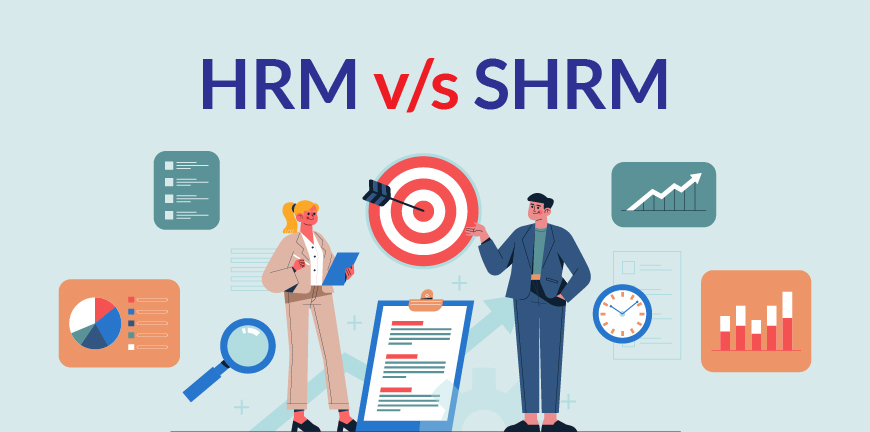
Possible Impact of 6G on the Labour Market
13/06/2023
HRM vs SHRM – Definition, Objectives, Key Differences
22/06/2023- What is Staff Augmentation?
- What is the Staff Augmentation Process?
- What are the Pros and Cons of Staff Augmentation?
- What are the Challenges in Staff Augmentation?
- What are the Staff Augmentation Best Practices?
- Difference between Managed Services and Staff Augmentation
- Conclusion
- Frequently Asked Questions (FAQ)
With the hit of the global recession and employees actively taking to the Quiet Quitting culture, staff augmentation services can truly be a saviour as they can eliminate operational costs and promptly fill talent gaps.
The dearth of skilled talent in the labour market is making it harder for talent acquisition teams to attract/ recruit the right employees for the open roles in their organizations. Filling in the gaps, especially for high-tech roles like machine learning engineers, developers, etc., is becoming challenging by the day. So, how do you tackle this challenge? By implementing the Staff Augmentation model.
Staff Augmentation is a proven, successful staffing model that is a perfect addition to your organization’s talent management plan. The global staffing Industry is known to be one of the biggest suppliers of staff augmentation talent, estimated to support 490$ billion in annual spending.
What is Staff Augmentation?
Staff augmentation is a type of outsourcing model where organizations hire workers temporarily or for a brief period to fill talent gaps and be part of the in-house team in the organization. It is designed to address specific skill gaps and meet the immediate talent needs required for a specific project.
The recent layoffs and economic uncertainty were indicators that companies need to have flexibility, agility, and responsiveness to adapt to market dynamics and customer expectations. Incorporation of the staff augmentation model is a great start to addressing the above problems. It provides a functional framework to add/remove staff in a timely, cost-effective manner.
What is the Staff Augmentation Process?
1. Identification of the problem
Identifying the shortfalls is a good place to start. Establish employee contracts and conduct interviews to find candidates that meet your talent needs. Get feedback from your in-house employees; they are the ones who have first-hand knowledge of how and where the organization thrives or fails. Communicate your needs clearly with your staffing service provider.
2. Specify the requirements
Defining your requirements specifically is crucial if you are looking to get your desired outcomes from the staff augmentation model. Also, you need to decide on the specific staffing tasks you need assistance with, like- do you need assistance with one particular task/ marketplace strategies/ others, type of skills, expertise you are looking for in the candidate, etc. Provide your staffing provider with a clear description of the job profile and the candidate profile requirements.
3. Search Strategy
Upon sharing your specific candidate/team augmentation requirements with your staffing provider, the search commences. The search strategy for finding suitable candidates could involve several processes, like reviewing the suitability of applicants, conducting interviews, or any specific tests that you would like them to take, to ensure their ability to execute the project at hand.
4. Onboarding
Once you have reviewed and selected the candidates to be part of your team, we will help you with the onboarding process. We help them understand your company’s work culture and help them settle into the new workplace. As your staff augmentation service providers, we will ensure complete candidate care until they get comfortable in the new organization.
5. Ongoing support
To ensure efficient cooperation, we provide ongoing support post the onboarding process, facilitating a smooth transition for both the employee and employer. A good third-party provider will encourage feedback from the augmented employees in your organization to help you build a strong, healthy relationship with them, to achieve better results and outcomes.
What are the Pros and Cons of Staff Augmentation?
There are pros and cons to every service. Likewise, while there are plenty of benefits of the staff augmentation model, there are a few cons associated with it as well.
Benefits of the staff augmentation services
1. Dedicated, on-demand, skilled candidate/team
Depending on your business needs and role requirements, your third-party staffing provider will select and deploy a talented, certified, experienced candidate to address the talent gap and work on your specified project requirements.
2. Agile, Flexible, and Scalable
If you require a skilled professional to be deployed in your organization on an urgent basis, a staffing provider will work swiftly to equip your team with a specialist. Based on your requirement, this model allows you to scale up or down as per your business needs.
3. Cost-effective
A permanent employee can typically cost you 1.25 to 1.4 times the salary if you account for the benefits, compensation, etc. With a staff augmentation model, you can hire temporary staff who will not be part of a contract that accounts for benefits, thereby saving overhead costs.
4. The elimination of a training phase
A certain amount of training is necessary when you onboard a new employee. But with a staff-augmented employee, you can eliminate the training part almost entirely, saving you resources like time and effort.
5. End-to-end recruitment
A third-party staffing provider will have an experienced HR (Human Resources) team that handles every aspect related to HR management, right from the on-demand supply of skilled candidates, profiling, and selection to onboarding them and any other function that falls under the candidate’s care.
What are the Challenges in Staff Augmentation?
1. High long-term cost
If your staffing requirements become more of an ongoing necessity, then it will end up costing you more, because you will be paying to supplement skilled talent to your team. But of course, the right staffing provider will be ready to negotiate the best deal for you.
2. Added processes
When a new worker joins your organization, there is that small phase that you have to go through to help them understand your company’s culture and fit into their role much faster than a regular employe,e because they are not in your company to stay, they are there for a period to successfully help you execute a certain project.
3. Lack of internal knowledge
A few projects may require past knowledge associated with the work or the client you are working with. Familiarity helps in working together with the client. An augmented staff member obviously would not have any knowledge about it and will need some time to catch up.
What are the Staff Augmentation Best Practices?
We have compiled some of the best practices to follow to implement the staff augmentation model correctly. Take a look.
- Define job roles and expectations as clearly as possible.
- Maintain constant, open, transparent communication with the augmented employees in the workplace.
- Project and Communication management tools.
- Transferring of knowledge and documentation of the process of the project at hand.
- Staying involved- Ensuring that the augmented staff member stays on track throughout the augmented process.
- Respect the differences among augmented staff members. It is important to make each and every employee feel included and part of the organization.
- Recognize and if needed, reward the efforts of augmented staff members. It will have a direct effect on their morale, motivation, engagement, and productivity.
- Make sure the terms of confidentiality are in place.
- Ensure easy project scalability.
- Choose a trusted and reputable staff augmentation provider.
Difference between Managed Services and Staff Augmentation
Managed services and staff augmentation are used interchangeably by many, considering they have their roots in IT (Information Technology) outsourcing. While they may have a few characteristics that are similar to one another, they are not the same.
We have outlined some of the broad differences between the two outsourced models. They are-
| Staff Augmentation | Managed Services | |
|---|---|---|
| Funciton | Focuses on the bigger picture & is committed to delivering an outcome | Focuses on the completion of specific tasks, committed to providing input |
| Service offered by | Managed service providers (MSPs) | Hires, personnel, etc. |
| Provision of training | An MSP (Managed Services Provider) offers training to the personnel | The workers will be training on the client processes |
| Financials | Charged a monthly fee based on the project for a specific period | Charged based on the working hours, the number of personnel hired |
| Coverage | Defined by Service Level Agreements | Defined by the scope of their work |
Conclusion
Using staff augmentation models lets business owners address the talent gaps, as well as keep track of the project. Not only do they get to choose the talent they deem fit for the role, but maintain authority over the project to get things done their way.
Staff augmentation allows you to access a global talent of highly skilled developers and engineers to work alongside your in-house teams to optimize overall competencies and boost productivity.
Alp Consulting has been a well-known name in the staffing and recruitment industry. If you are looking for trusted staff augmentation service providers, contact us, and we will help you find the perfect staffing solution that fits your business needs.
Frequently Asked Questions (FAQ)
1. What does Staff Augmentation mean?
Staff Augmentation is an outsourcing strategy that is used to hire skilled talent from outside the organization, temporarily, to augment the capacity of your organization. Augmented staff are generally hired to address the skill gaps required for the completion of a specific project or a function.
2. How to manage staff augmentation?
To manage and execute the business practice of staff augmentation successfully, you need to follow steps like setting clear objectives, identifying skill gaps accurately, respecting the culture and other differences of augmented staff, and offering them the recognition they need.
3. What are the types of staff augmentation services?
The four major types of staff augmentation are On-site staff augmentation, Remote staff augmentation, Project-based staff augmentation, and Team-based staff augmentation, each differing from the other in terms of location or scope.
Contact Us For Business Enquiry

Kasthuri R
Kasthuri R is the Co-Founder & Executive Director at ALP Consulting, bringing over 23 years of experience in search, staffing, and HR consulting. She has been instrumental in driving ALP’s recruitment, employee leasing, and executive search practices across diverse industry verticals. With deep expertise in talent acquisition, HR strategy, and operational management, Kasthuri has built scalable, client-focused solutions that enhance workforce efficiency. Her strategic leadership continues to steer ALP Consulting toward innovation and excellence in people management.


